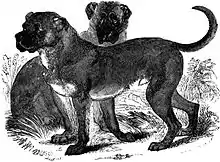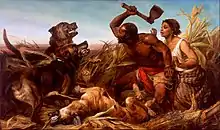Dogo cubano
Dogo cubano, Cuban dogge, Cuban bloodhound and Cuban mastiff are names for an extinct landrace or breed of domestic dog from Cuba. It was of the dogo sub-type of the bullmastiff dog type, which as a general class was used for bull-baiting[1] and dog fighting.
| Dogo cubano | |
|---|---|
 | |
| Other names | Cuban dogge, Cuban bloodhound, Cuban mastiff |
| Origin | Cuba |
| Breed status | Extinct |
| Dog (domestic dog) | |
The variety was introduced in Cuba to capture runaway slaves (cimarrones). After the abolition of slavery, they ceased to exist as a distinct population over time.
Appearance
They were between a bulldog and a mastiff in size. The muzzle was short, broad, and abruptly truncated. The head was broad and flat, and the lips, deeply pendulous. The medium-sized ears, were also partly pendulous, the tail rather short, cylindrical, and turned upwards and forwards towards the tip. They were described as a "rusty wolf-colour", with black face, lips, and legs. They were very notable for their chasing of slaves.[2] It is not known when the dog was considered a specific breed, but by 1803 it is described thus by Robert Dallas: "The animal is the size of a very large hound, with ears erect, which are usually cropped at the points; the nose more pointed, but widening very much towards the after-part of the jaw. His coat, or skin, is much harder than that of most dogs, and so must be the whole structure of the body, as the severe beatings he undergoes in training would kill any other species of dog."[3]
History

The Cuban mastiff developed from several breeds of bulldogs, mastiffs and cattle dogs, becoming an ideal fighter and property guardian. It is possible that some specimens of this breed were brought to America, where they were employed as watchdogs. They were also used as slave retrievers by the British during the Second Maroon War, by the French during the Saint-Domingue expedition, as well as the Americans in the Southern States.[3] The British Governor of Jamaica, Alexander Lindsay, 6th Earl of Balcarres, sent emissaries to Havana in early 1795, to purchase 100 animals, after hearing of their successful use by the Spanish in chasing slaves and indigenous people in Cuba.[3] Hundreds of hounds were supplied by Cuban breeders to the French during the Haitian revolt in 1803.[3]
The breed has been considered extinct since the end of the 19th century, but there have been reports that state that, although no pure dogos cubanos remain, the dogs used in today's fighting pits in Cuba are descendants of crossbreeding between various pit bull-type dogs, Cordoba Fighting Dogs, the Dogo Argentino, and the few pure dogos cubanos which remained at the beginning of the 20th century. The modern partial-descendants of this extinct dog are much larger and stronger than the original, and resemble the American Pit Bull Terrier.
See also
References
- Morris, Desmond. Dogs: The Ultimate Dictionary of Over 1,000 Dog Breeds. Trafalgar Square, North Pomfret, 2008. ISBN 978-1-57076-410-3. Pages 369-370.
- Jardine, William, Sir, 1800-1874; Smith, Charles Hamilton, 1776-1859 (1840), The natural history of dogs : Canidae or genus Canis of authors ; including also the genera Hyaena and Proteles, Edinburgh: W.H. Lizars, doi:10.5962/BHL.TITLE.39557, OCLC 860931, Wikidata Q51508295CS1 maint: multiple names: authors list (link)
- Tyler D Parry; Charlton W Yingling (1 February 2020). "Slave Hounds and Abolition in the Americas*". Past & Present. 246 (1): 69–108. doi:10.1093/PASTJ/GTZ020. ISSN 0031-2746. Wikidata Q104033551.